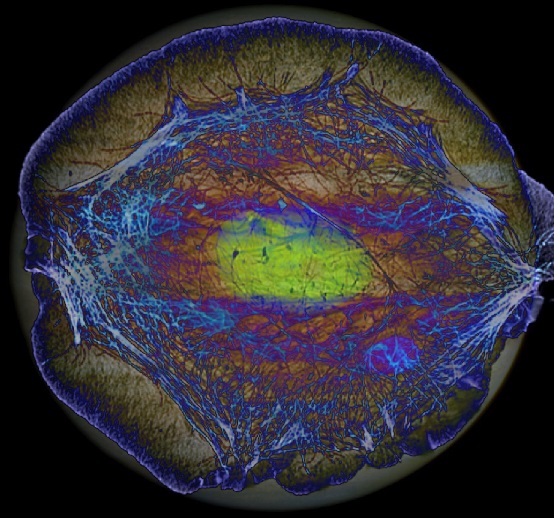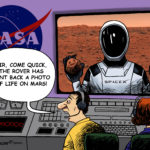By David Grinspoon (Planetary Science Institute).
We can try to devise rules for how detecting alien life should unfold, but E.T. might not play along.
Cite as: Grinspoon, D. (2022) “Grave Expectations”. Primordial Scoop, e20220419. https://doi.org/10.52400/OWTT5804
We are a long way from having a Star Trek tricorder to scan for “life signs.” On several occasions, the peer-reviewed literature has reported indications of past and present life beyond Earth that further study found to be unsubstantiated. The scientific enterprise has survived these false starts; our error-correction processes have worked well. But in the time between an initial report of a possible biosignature and a later nonbiological explanation, the mass media and the public often let their imaginations run wild.
Another of the sexiest perennial space-science stories after possible hints of alien life are asteroids threatening Earth. In 1999, worried that their credibility might suffer if the public saw them as crying wolf, astronomers devised the Torino scale to categorize possible impact threats, ranging from “0” (no danger) all the way up to “10” (near-certain global catastrophe).
Last October a group of scientists, including leading astrobiology officials at NASA, proposed in Nature an analogous scale to rate reports of possible alien life detection (https://is.gd/CoLDscale). In the Confidence of Life Detection, or CoLD, scale, a “1” could possibly be caused by life. A “2” means sources of contamination are ruled out. It’s a “4” if non-biological sources are shown to be implausible. And so on, up to the highest level, a “7,” when independent follow-up observations confirm the life hypothesis and we can finally declare to all the world (and whoever else is listening), “It’s life, Jim!”
This effort toward a unified approach arose after astrobiology leaders at NASA grew unhappy with the attention given to the reported discovery of phosphine on Venus (S&T: Jan. 2021, p. 15). The media widely focused on the finding as being a possible sign of life, even though the phosphine authors were very careful to stress that they regarded life as an interpretation that should only be accepted if all others were ruled out.
So, what were the NASA authors really so upset about? Maybe they were disturbed by a possible discovery that was not where and what we expected. NASA is heavily invested in searching for habitability on Mars, Europa, and elsewhere, including exoplanets. We hold workshops and design instruments to detect life in these places. We know that the first signs — an isotopic anomaly among organic deposits on Mars, or a disequilibrium mixture of gases on an exoplanet — will be ambiguous, and we know how we’ll follow up to rule out other explanations.
But life may not follow our script, and its discovery may not cleanly fit into a linear numbered scale. Ambiguity and disagreement might make us uncomfortable, but we’re talking life, not a rock hurtling through space following well-known laws of motion. We might well find a biosignature where we don’t expect it.
To me the CoLD scale reads almost as a science-fiction story in which the authors have agreed on how they expect the discovery of life will unfold. It’s fine to run through scenarios and hold provisional expectations, but when these become officially recognized by those running the programs that hand out funding, we may fall into “groupthink” and miss something important. The history of planetary exploration suggests that some of the most important discoveries will arrive in surprising ways that were not in the proposals used to justify our missions.
This article originally appeared in print in the May 2022 issue of Sky & Telescope.




As an interesting question of recent history, the CoLD standard may not have originated because “astrobiology leaders at NASA grew unhappy with the attention given to the reported discovery of phosphine on Venus”. According to a personal communication from Shawn Domagal-Goldman, Branch Head in the Planetary Systems Laboratory at the NASA Goddard Space Flight Center, the topic was being discussed before the Venus phosphine publication emerged, suggesting that the nearly contemporaneous appearance of CoLD coincidental.